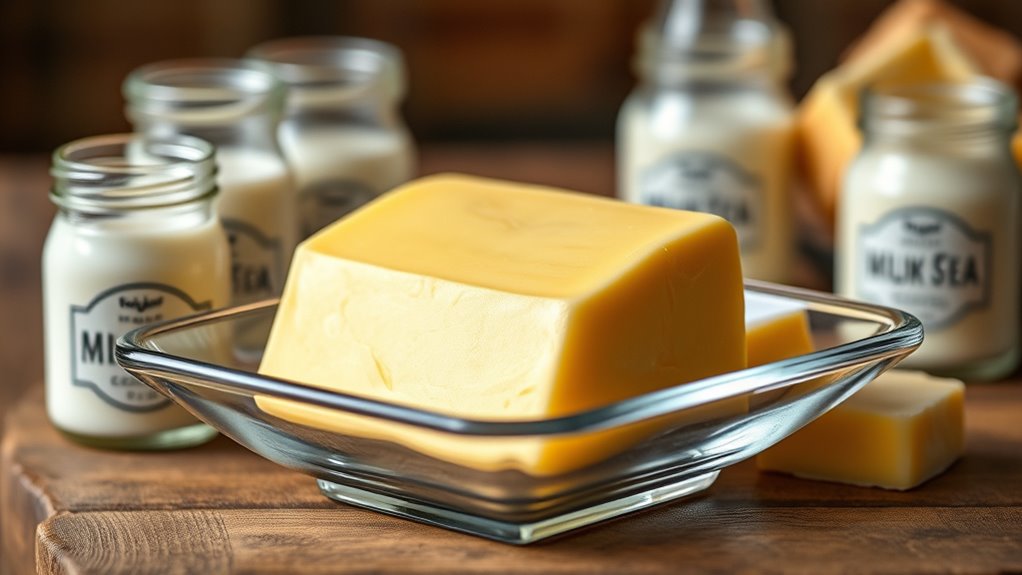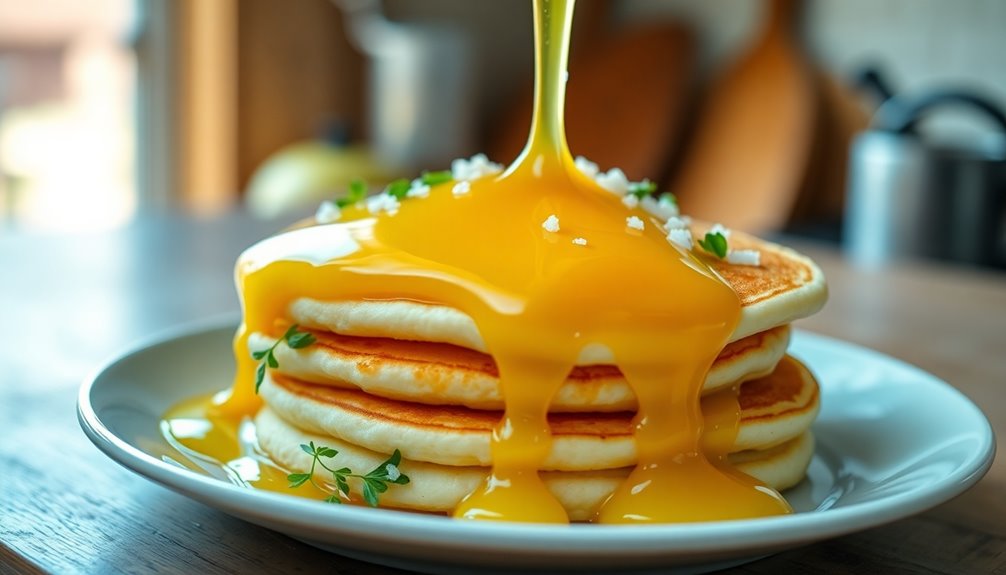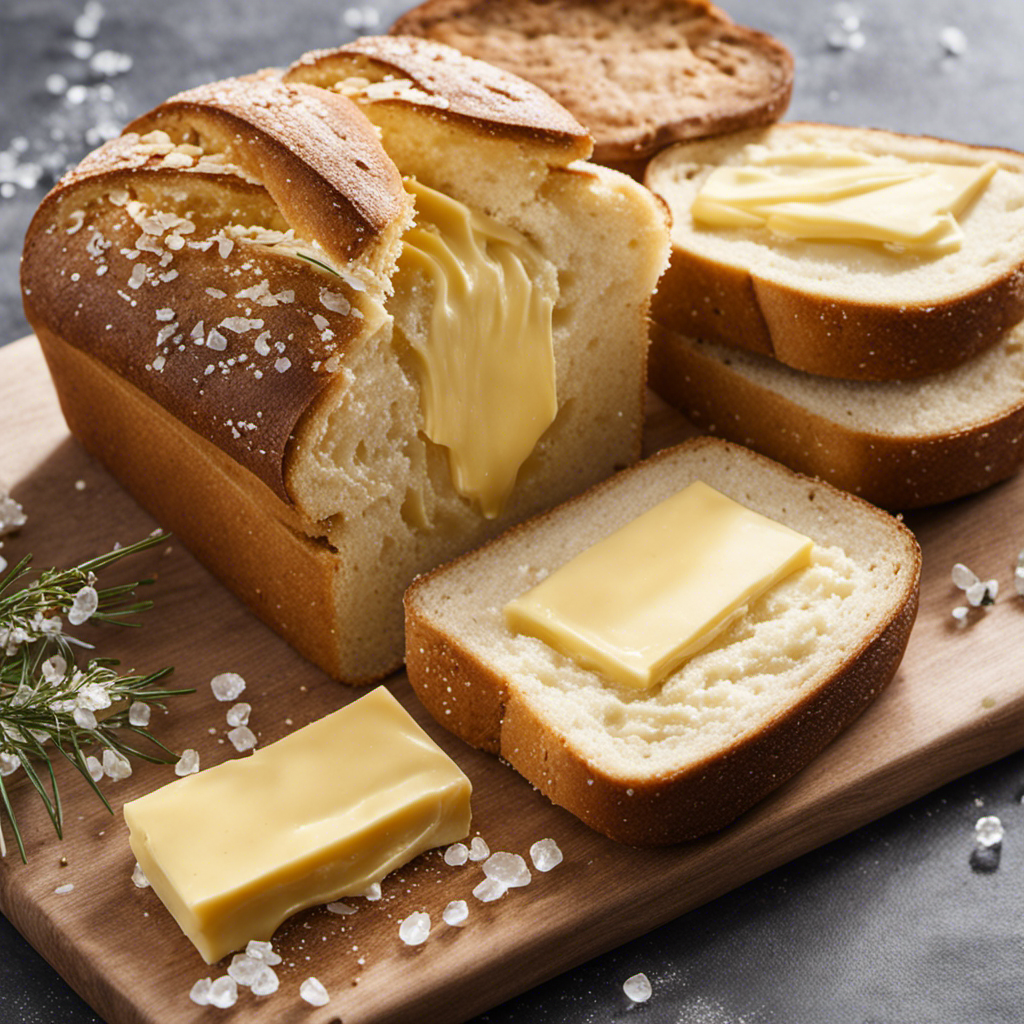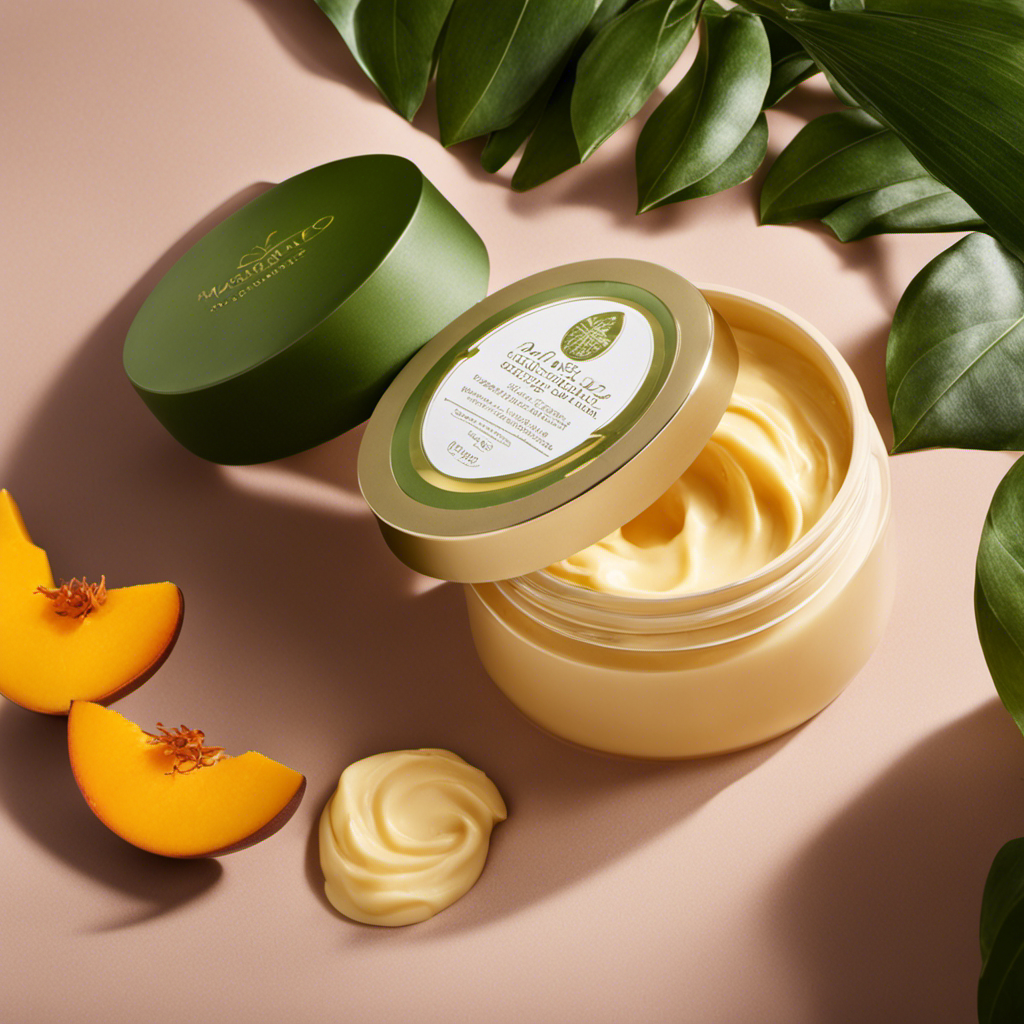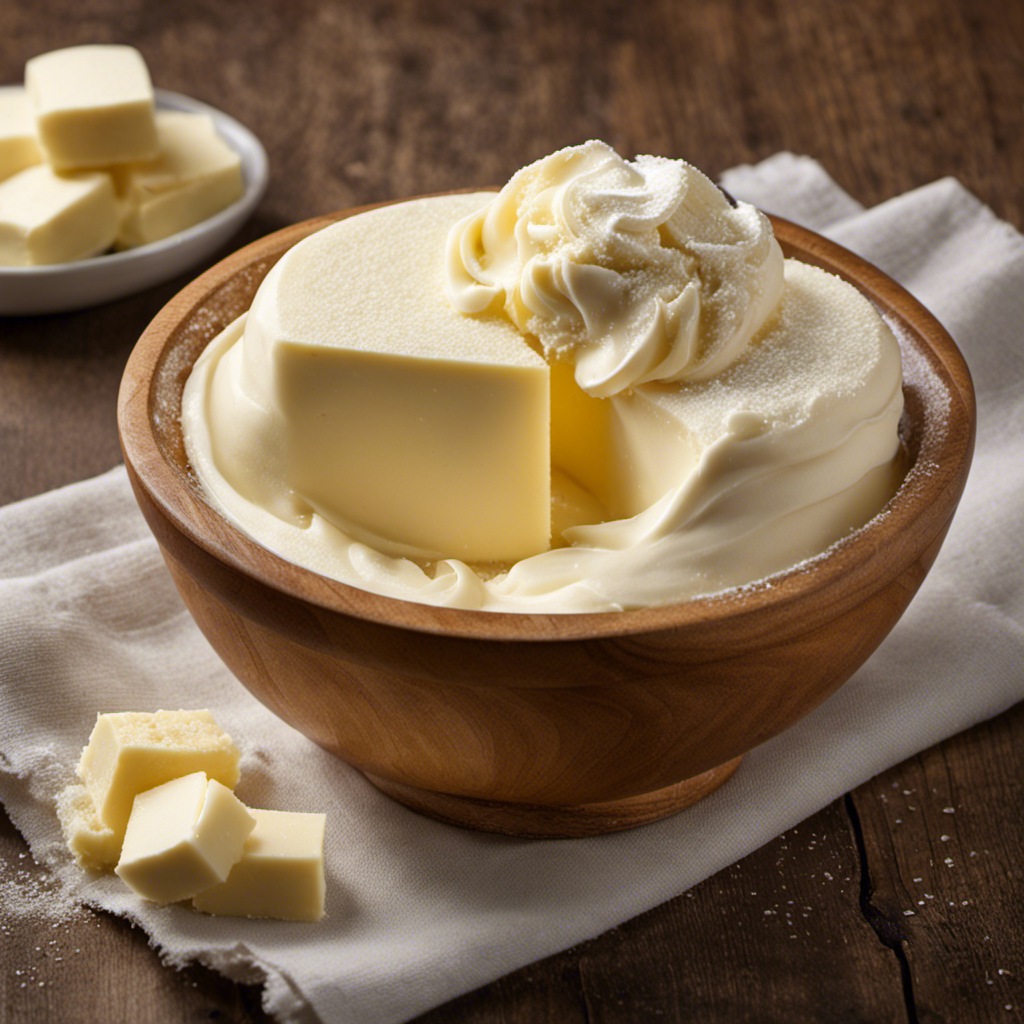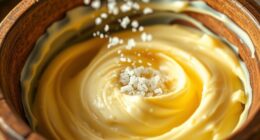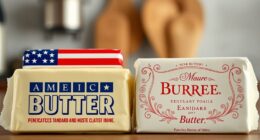European-style butter typically contains between 82% and 85% fat, making it richer and creamier than American versions, which usually have around 80%. This higher fat content enhances flavor, texture, and cooking performance. The percentage is measured through precise testing, and labels reflect these standards. Understanding these differences helps you choose the best butter for your recipes. Keep exploring to discover more about how these variations impact your culinary creations.
Key Takeaways
- European-style butter typically contains 82-85% butterfat, higher than American standards of around 80%.
- Fat content influences flavor, texture, and cooking performance, making European butters richer and creamier.
- Precise measurement methods like Gerber testing and centrifugation ensure accurate fat percentage labeling.
- Regional standards and traditions shape the typical fat levels and culinary uses of European-style butters.
- Higher fat percentages enhance mouthfeel, stability, and suitability for baking and gourmet applications.
Understanding Butter Fat Content and Its Significance
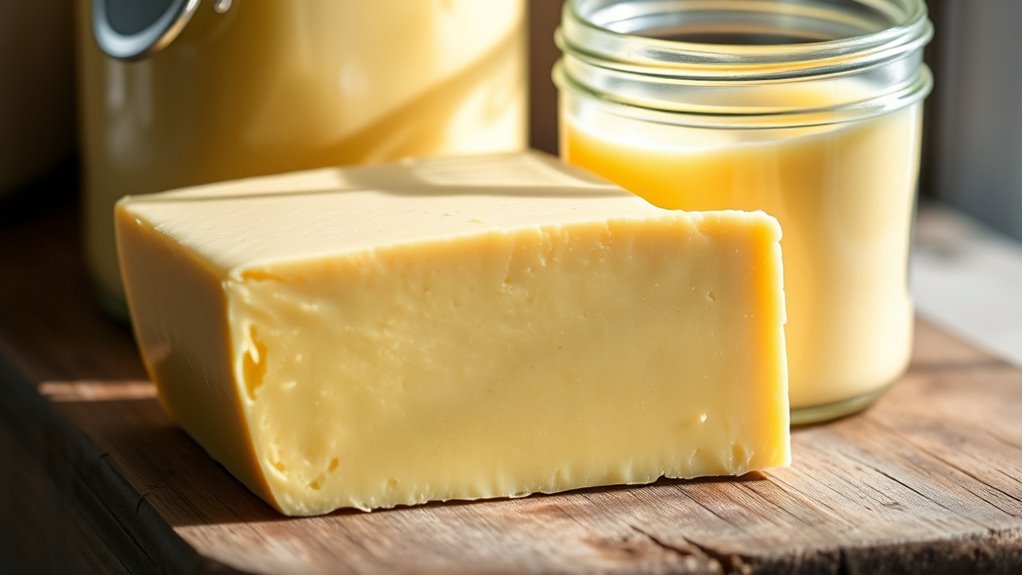
Understanding butter fat content is essential because it directly affects the quality, flavor, and texture of butter. Cultural influences shape how different regions prioritize fat levels, with some traditions favoring richer, creamier textures, while others emphasize lighter options. Historically, origins of butter-making techniques reveal how varying climates and farming practices determined fat content. For example, European countries with high-fat dairy traditions developed methods to produce butter with specific fat percentages, which became a mark of quality and regional identity. Recognizing these factors helps you appreciate why butter varies globally and why European-style butter often has higher fat content. Additionally, regional dairy practices have historically played a significant role in shaping the typical fat percentages found in European butter, influencing consumer preferences and culinary traditions. This historical context and cultural influence underscore the significance of fat percentage, impacting everything from culinary uses to consumer preferences.
How European-Style Butter Is Processed and Made

You’ll notice that traditional churning techniques play a key role in creating European-style butter, ensuring a rich and consistent texture. Quality control standards are strict, so every batch meets high purity and fat content requirements. By understanding these processes, you can appreciate the craftsmanship behind authentic European butter. Additionally, some producers incorporate music therapy principles to enhance the quality of their dairy products through mindful practices during processing.
Traditional Churning Techniques
Traditional churning techniques for European-style butter involve gently agitating fresh cream until the fat separates from the liquid, creating a rich, concentrated product. During butter churning, you carefully control the process to encourage milk separation, ensuring the butterfat clumps together efficiently. Unlike mass-produced methods, this traditional approach minimizes agitation, preserving the cream’s natural qualities. As the fat begins to coalesce, you can see the butter forming, while the remaining buttermilk stays separate. This careful process results in butter with higher fat content and a distinct texture. By focusing on precise milk separation, artisans produce European-style butter with unique flavor profiles and ideal fat percentages, maintaining the traditional craftsmanship that sets it apart from industrial varieties and color accuracy in processing.
Quality Control Standards
European-style butter production adheres to strict quality control standards that guarantee consistency, purity, and flavor authenticity. From dairy farming to milk processing, every step is carefully monitored. Dairy farms maintain high standards for the health and diet of cows, ensuring the milk’s quality. During milk processing, rigorous testing confirms the milk’s composition and safety. Only the freshest, highest-quality milk moves forward. The production facilities follow strict hygiene protocols to prevent contamination. Regular quality checks verify fat content, texture, and flavor characteristics to meet European regulations. These standards ensure each batch of butter maintains its traditional qualities and consistent fat percentages. Additionally, the use of regional flavors and traditions plays a vital role in shaping the unique profile of European-style butter. By adhering to these meticulous procedures, producers deliver authentic European-style butter with reliable quality and distinctive flavor profiles.
Common Fat Percentages in European vs. American Butters
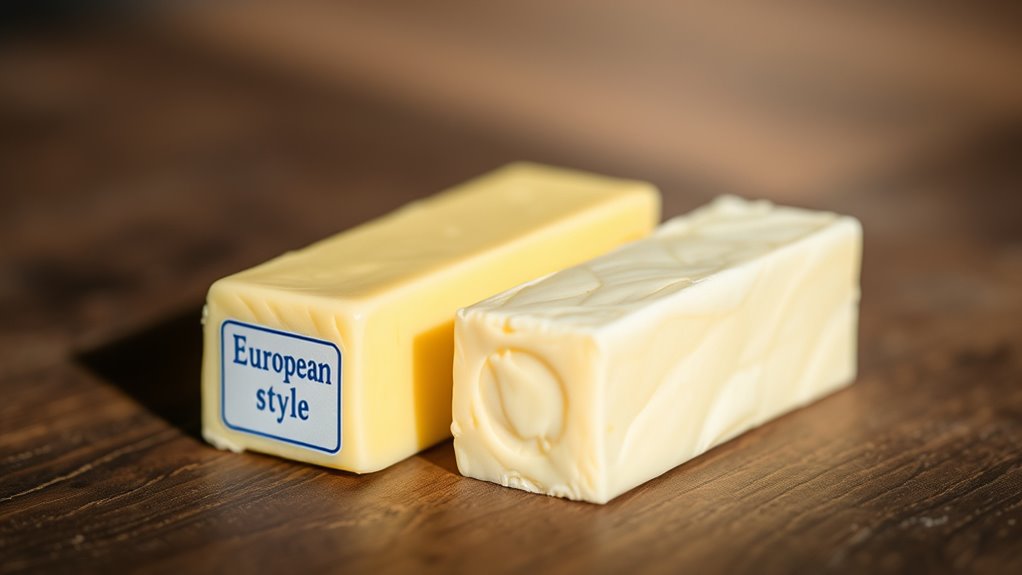
European butters typically have a higher fat content, often around 82-85%, compared to American butters, which usually range from 80% and sometimes less. These differences influence the texture and flavor you experience in baked goods and spreads. Understanding these standards helps you choose the right butter for your culinary needs. Additionally, the different regulations and standards across regions contribute to these variations in fat content regulatory standards in dairy.
Typical European Fat Levels
Have you noticed that European butters often have higher fat content than their American counterparts? This difference stems from cultural preferences and historical practices that prioritize richer, creamier textures. In many European countries, butter typically contains around 82-84% fat, emphasizing quality and flavor over mass production. These standards reflect longstanding traditions where butter was a staple ingredient, valued for its taste and culinary versatility. European dairies often focus on traditional methods, resulting in higher fat levels that enhance mouthfeel and cooking performance. Additionally, the emphasis on natural ingredients and minimal processing contributes to these elevated fat percentages, setting European butters apart from American varieties. By contrast, American butters generally have lower fat percentages, usually around 80%, due to different regulatory standards and consumer preferences. Understanding these typical European fat levels helps you appreciate the nuances that influence butter’s texture and flavor across regions.
American Butter Standards
American butter standards generally specify a minimum fat content of 80%, which is slightly lower than the typical 82-84% found in many European butters. This difference influences butter flavor, often resulting in a milder taste profile in American varieties. When considering packaging design, American butters tend to emphasize clarity and convenience, highlighting fat content and quality. Key points include:
- The 80% minimum fat content aligns with regulatory definitions, ensuring consistency across products.
- Butter flavor in American butters may be less intense but still rich and creamy.
- Packaging design often features clear labeling to communicate fat percentage and origin.
- Variations in fat content can affect melting properties and culinary applications.
- The Gold IRA markets showcase how different standards and transparency can influence consumer trust and perception in specialized markets.
Understanding these standards helps you appreciate the subtle differences in butter quality and presentation.
Comparing Fat Content
While butter standards vary across regions, the typical fat content in European butters generally ranges from 82% to 84%, making them richer and more concentrated than many American varieties. This higher fat percentage enhances butter flavor, giving it a creamier, more intense taste experience. American butters usually contain around 80% fat, which results in a slightly lighter flavor. The increased fat content in European butter also influences packaging materials, often requiring thicker, more durable wrappers to preserve freshness and prevent spoilage. When comparing the two, you’ll notice European butters tend to have a more luxurious texture and richer flavor due to their higher fat content. Additionally, the regional standards for butter fat percentages can impact how the product is labeled and marketed in different countries. Understanding these differences helps you choose the right butter for baking, cooking, or spreading, depending on your flavor preferences.
The Role of Milk Composition in Determining Fat Levels

The composition of milk directly influences its fat content, making it a crucial factor in determining butter fat percentages. Variations in milk composition affect the fat percentage you can expect in the final product. Specifically, factors include:
- The breed of the dairy cow, which impacts overall milk composition.
- The cow’s diet, influencing fat and nutrient levels.
- The stage of lactation, altering fat content over time.
- Environmental conditions, affecting milk quality and composition.
Understanding these elements helps you predict and control butter fat percentages. Higher fat levels in milk generally lead to richer butter, while lower fat content results in lighter products. Ultimately, milk composition plays a vital role in defining the butter’s fat percentage you aim to produce.
Measuring and Labeling Butter Fat Percentages

How do producers determine the butter fat percentage in their products? They typically use a method called the Gerber test, which involves centrifuging a sample to separate the fat from the milk solids. This precise measurement guarantees the butter’s fat content aligns with regulations and desired quality standards. Once measured, the butter fat percentage is displayed clearly on packaging design, helping consumers make informed choices. Accurate labeling not only reflects the butter’s quality and flavor profile but also builds trust. In European-style butters, the high butter flavor often correlates with higher fat content, so precise measurement is essential. Proper labeling reassures you about what’s inside, emphasizing transparency and quality, which are vital for both producers and discerning buyers.
Culinary Impacts of Different Butter Fat Levels

Higher butter fat levels considerably influence the texture, flavor, and cooking properties of your dishes. With richer butter, you’ll notice a more pronounced butter flavor, enhancing baked goods and sauces. The higher fat content also impacts culinary applications in these ways:
Richer butter enhances flavor, texture, and cooking stability in your culinary creations.
- Creaminess: Elevated fat yields smoother, silkier textures in pastries and spreads.
- Flavor Intensity: A richer butter flavor amplifies the taste of baked items and sautés.
- Cooking Stability: Higher fat helps butter withstand higher temperatures without breaking down, ideal for frying.
- Moisture Retention: Increased fat keeps baked goods moist and tender.
- Sound design Understanding these impacts helps you select the right butter for precise culinary outcomes, ensuring each dish achieves its best flavor and texture.
How to Choose the Right Butter for Your Recipes
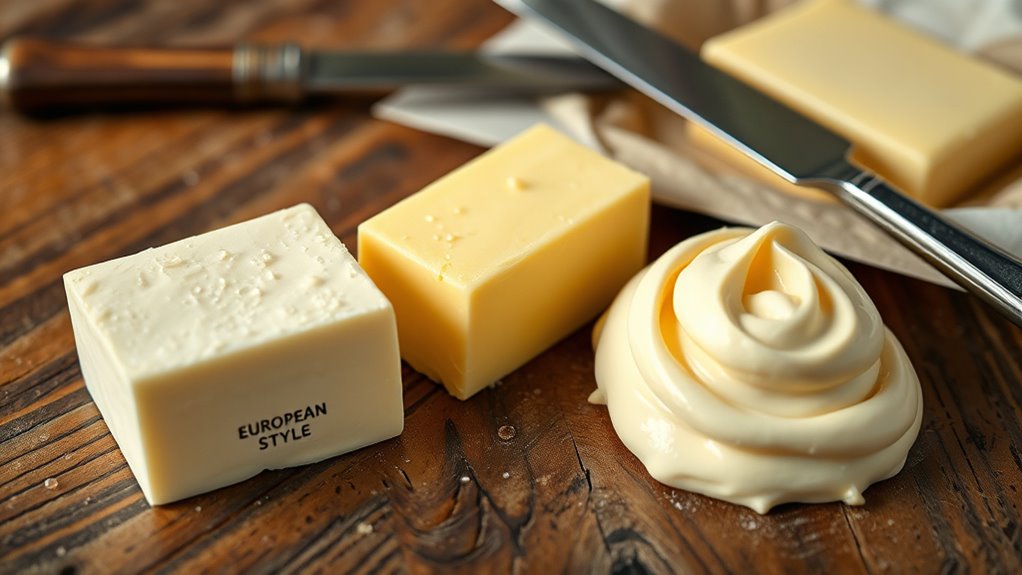
Choosing the right butter for your recipes depends on understanding how its fat content will influence the final result. Higher-fat European-style butters create richer textures and more intense flavors, ideal for pastries and spreads. Lower-fat options may suit lighter baked goods or health-conscious recipes. When selecting butter, consider the health benefits; some butters contain added nutrients or are made from grass-fed cows, offering extra benefits. Proper storage techniques are also essential to maintain freshness and prevent spoilage, especially for high-fat butters that can become rancid more quickly. Keep butter in an airtight container in the refrigerator, and avoid prolonged exposure to light and heat. Additionally, electric heated mattress pads are generally considered safe when used as directed, providing a comfortable warmth that can enhance your relaxation during chilly days. Choosing the right butter ensures your dishes taste better and remain fresh longer, aligning with both your culinary goals and health considerations.
Tips for Using European-Style Butter in Your Kitchen

To get the best results when using European-style butter, it’s important to pay attention to its unique qualities, such as its higher fat content and creamier texture. These factors influence both butter flavor and how you store it. To maximize flavor and freshness, consider these tips:
- Store butter in an airtight container in the refrigerator to preserve its delicate flavor.
- Keep it away from strong-smelling foods, as European butter easily absorbs odors.
- For baking, soften butter at room temperature, allowing it to reach an ideal consistency for creaming.
- Use European-style butter promptly after opening to enjoy its rich, authentic flavor, which enhances dishes with its creaminess and depth. Proper storage methods guarantee your butter retains its quality and flavor, elevating your culinary creations.
Frequently Asked Questions
How Does Butter Fat Percentage Affect Shelf Life?
You might notice that higher butter fat percentages can impact storage stability, making butter prone to spoilage faster if not stored properly. Fat acts as a preservative, so butter with more fat tends to last longer, but it still requires airtight containers and cold temperatures. Lower fat butter may have a higher spoilage risk because it contains more moisture, which encourages microbial growth. Proper storage is key to extending shelf life regardless of fat content.
Are There Health Benefits Associated With Higher Fat Butters?
Imagine spreading rich, creamy butter on warm bread—those higher fat butters often seem more indulgent. You might think they offer butter health benefits, like improved flavor and texture, but note that higher fat content can also mean more calories. While some believe fat benefits include better absorption of fat-soluble vitamins, it’s essential to enjoy these butters in moderation. Ultimately, choosing butter depends on your dietary goals and preferences.
Can I Substitute Different European Butters in Recipes?
You can definitely substitute different European butters in recipes, but keep in mind their butter consistency and flavor profiles. Some European butters are creamier and richer, which can enhance the dish, while others might be slightly saltier or milder. Adjust your measurements if needed, and taste as you go. Experimenting helps you discover which European butters work best for your recipes, ensuring great results every time.
How Does Climate Influence European Butter Fat Content?
Climate variation acts like a painter’s brush, coloring milk composition and influencing butter fat content. When you consider how different European regions experience varying temperatures and rainfall, it’s clear these factors shape the richness of the milk. Warmer, drier climates tend to produce milk with higher fat, while cooler, wetter regions often yield lower fat content. So, climate plays a crucial role in the butter’s creaminess you enjoy.
Are There Regional Differences in Butter Fat Standards Across Europe?
You’ll find regional variations in butter fat standards across Europe, reflecting local dairy traditions and regulations. These differences influence culinary applications, as higher-fat butters are preferred for richer baked goods and sauces in some regions, while others favor lighter options. Understanding these regional standards helps you choose the right butter for your recipes, ensuring authentic flavors and ideal results, whether you’re making pastries in France or spreads in Scandinavia.
Conclusion
Now that you understand European butter’s higher fat content, you might find it’s the secret ingredient your recipes have been missing. From richer flavors to better textures, the difference is noticeable—and it’s no coincidence. Next time you choose butter, consider the fat percentage and how it can elevate your cooking. Embrace these subtle nuances, and watch your dishes become even more delicious—sometimes, the smallest details make the biggest impact.
